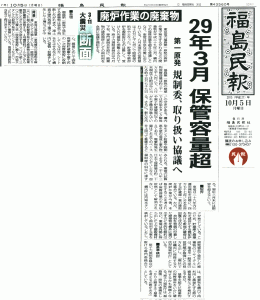Original Japanese written by staffer
The English below translated from the original Japanese by Heeday
The English translation edited by Rev. Dr. Henry French, ELCA
(Source: article of October 5th, 2015 edition of the Fukushima Minpo newspaper)
▼Click the image to enlarge it and read the caption.

The decommissioning work, currently in progress, of TEPCO’s Fukushima Daiichi Nuclear Power Plant (NPP) has been producing huge amounts of debris and other waste. Now, such waste is expected to exceed the full storage capacity on the NPP’s premises in March 2017. TEPCO is thus facing an urgent task. As of the end of August 2015, the storage capacity is already half full.
The premises accommodate numerous tanks containing contaminated water. It is hard to secure space for more storage and incinerators that burn waste to reduce its volume.
There is no legal restriction to removing waste containing radioactive substances from the premises. TEPCO is considering removing it and then reusing it as building materials. At the same time, however, the power company is aware that many building subcontractors and general citizens are reluctant to reuse waste from a NPP accident. Thus, according to the company, “Currently, the best way is to store such waste on the NPP’s premises.”
Japan’s Nuclear Regulation Authority is expected to set up a new committee dedicated to this issue, which should begin discussions on what to do with such waste. The Authority’s preferred choice currently is to reuse the waste as building materials.
Many countries in Europe and North America are ahead of Japan in the “age of decommissioning,” and they have already chosen sites for burying low-level radioactive waste. The burying of such waste is already in progress.
According to sources from the prefectural government of Fukui and others, the US, by August 2014, had decided to decommission 27 of its 127 NPP reactors. Of these 27, the decommissioning of 10 is already completed. The low-level radioactive waste from this decommissioning is buried in four vast disposal sites established in states like Utah and Texas, etc.
A world leader in “going nuke-free,” Germany, has decided to decommission 23 of its 32 NPP reactors, almost 70%. Nine of them are currently in operation, and they too are to terminate their operation by 2022. This means that the nation will produce huge amounts of radioactive waste in and shortly after 2022. The German government is responsible for what to do with such waste and has been building disposal sites. This is a major difference from Japan, where the power companies are responsible for disposing waste from their NPPs.
Final disposal sites for radioactive waste pose another problem. At this moment, of all the countries of the world, only Sweden and Finland have chosen such sites. A public relations person from Sweden’s Swedish Nuclear Fuel and Waste Management Company (SKB) says, “It took 30 years of research before we chose the final site.” The company surveyed everywhere within Sweden and considered every possible scenario, from an earthquake to the next ice age, according to Deutsche Welle, an international broadcast service of Germany.
As Japan faces the age of decommissioning many of its existing NPPs, we already see a limit to what power companies can do with respect to nuclear waste disposal sites. I believe the national government will have to take the initiative. In that case, however, I am worried that rural regions will be sacrificed again as disposal sites. For example, Fukushima was producing power consumed by Tokyo, until recently.
Also, the Japanese government set up “clearance levels,” allowing some very low-level radioactive waste to be treated as general waste, not “radioactive.” This means such radioactive waste can be reused and find its way into our everyday lives. No one is certain as to what such reuse will do to us. (For your reference, please visit http://www.chernobyl-chubu-jp.org/_userdata/kawata42.pdf part of a Japanese website containing writings by Mr. Masaharu Kawada, a molecular biologist helping Chernobyl refugees.
Capitalist economy, addicted to the pursuit of wealth, has its dark side, such as NPPs. If our future generations have to pay “the price” for NPPs, what kind of a world will it be? We have to keep the Fukushima Daiichi disaster in mind and be aware that it is time for us to change our value system.
